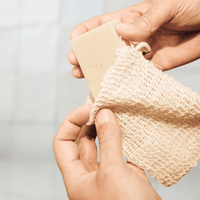
If you’re anything like us, you’re always looking for tips on how to be more sustainable. Beyond easing our eco-anxiety, finding new ways to go green is simply an important step we can all take to reduce our overall carbon footprint and work towards a healthier planet. Plus, sustainable living can make us happier. Indeed, research shows that doing good deeds — like reducing plastic waste, for instance — can boost our happiness by giving us a sense of purpose.
Of course, you don’t need to drive a Tesla or ditch your daily shower to start living a more sustainable lifestyle. Individual actions can and do make a big difference when made on a broad enough level.
Whether you’re new to the ever-growing green movement or already consider yourself an eco-savvy consumer, we encourage you to try these 20 sustainable living ideas that will help you become more environmentally conscious. With a few small changes to your lifestyle, you can lower your carbon footprint — one step at a time.
1. Shop with reusable bags.
Many municipalities now have rules that either ban single-use plastic bags or charge a nominal fee to use them. If your city hasn’t jumped aboard the plastic-free train, get a head start by bringing your own reusable shopping bag. (Bonus points if you also shop with muslin produce bags.)
2. Tackle dirty dishes without plastic.
Traditional dish soap contains a slew of harmful ingredients (hello, formaldehyde) and comes in a wasteful plastic bottle. Ditch the toxic chemicals and the plastic by switching to a solid dish soap bar. Our solid dish soap bar lathers well and cuts grease just as well as the bottled stuff, all while being better for your family and the planet. To make your dishwashing entirely plastic-free, consider pairing your dish soap bar with our beautiful wooden dish brush.

3. Plant flowers that attract pollinators.
Bees, birds and insects and other pollinators play a vital role in our ecosystem by pollinating the seed plants that grow our food. In fact, scientists say that pollinators are responsible for 35 percent of the food we eat. To help our diminishing populations of pollinators, consider planting a garden with pollinator-friendly native flowers. Even a small garden with a few vegetables and herbs can make a huge difference!
4. Become a single-car household.
Thanks to the increased popularity of remote work, becoming a single-car household is more attainable than ever. Along with reducing greenhouse gas emissions, using one car for the entire family will save you tons of money. If you and your partner both commute to work, map out your routes and see if carpooling is a viable option. Additionally, you can also consider alternative modes of transportation such as biking, walking or public transit.
5. Save leftovers with reusable bowl covers.
Replacing your plastic wrap with reusable bowl covers is a great way to cut back on single-use plastics. Unlike plastic wrap, our food-grade silicone bowl covers form an airtight seal around your mixing bowls and can withstand high temperatures (100 to 400 degrees F). Plus, they’re microwave and dishwasher safe!
6. Cook more meals at home.
We’re all guilty of grabbing takeout after a long day. But let’s face it — ordering food to go can produce a lot of waste. (Just think of all the single-use utensils, containers and napkins!) To reduce your environmental footprint, try to cook more at home. If you’re unmotivated to make your own meals, try to cook things you’ve been craving lately. And for days when you’re exhausted, have a few fallback recipes you can whip up with minimal effort. You can throw just about anything in a crockpot or on a sheet pan!

7. Eat more plant-based meals.
Switching to a plant-based diet — whether it be vegan, vegetarian or flexitarian — offers a host of health benefits, from increased energy to better heart health. Another reason to load up on plants? It can help decrease our reliance on animal products such as meat and dairy, resulting in fewer greenhouse gas emissions. You don’t need to quit everything cold turkey, though. To make the habit stick, start small by practicing Meatless Mondays with the family and then ramp up your efforts from there.
8. Buy clothes made from natural fibers.
Perhaps you’ve already taken the first step towards sustainable fashion by nixing fast fashion clothes from your wardrobe. That’s great! Now, it’s time to take the next step by choosing clothes made from natural fibers, such as organic cotton, hemp and linen. Unlike synthetic fibers, natural fibers don’t shed harmful microplastics into the environment. Natural fibers are also less toxic, making them a better choice for your family and the planet.
9. Host a clothing swap.
Clothing swaps are a great way to shop sustainably without spending a dime. Spread the word via email, Facebook groups or word of mouth and ask your invitees to bring clean, gently worn clothes. Chances are, someone is going to love your baby boy’s outgrown pajamas or that vintage sweater you no longer wear. (Tip: Don’t forget to supply snacks and drinks! Your guests will love sifting through clothes while sipping on tea and munching on delicious, plant-based snacks.)
10. Trade body wash for a natural body wash bar.
Body wash always comes in a plastic bottle and is often formulated with potentially harmful ingredients such as sodium lauryl sulfate and sodium laureth sulfate. Natural body wash bars, on the other hand, are plastic-free and contain plant-based ingredients that nourish your skin. Body wash bars also last longer than body wash, making them easier on your wallet as well. You can further extend their lifespan by using our soap saver bag to keep your bars dry in-between washes. (It doubles as a gentle exfoliator!)

11. Switch to a green energy provider.
The vast majority of Americans support renewable energy, but few have actually made the switch. It’s time for that to change! If you live in a state with a deregulated energy market, you have lots of options. Do your research and choose a renewable energy provider that meets your budget and energy needs. Stuck with only one energy provider? Visit their website and look for a green program that works for you. If they don’t have a green energy program, consider writing an email to the company expressing your desire for green energy.
12. Rethink your toilet paper.
The average American goes through a lot of toilet paper, clogging sewage treatment plants and contributing to a host of environmental problems like pollution and deforestation. If you want to be a little more environmentally conscious, consider switching your toilet paper to a variety that isn’t made with virgin forest fiber. Toilet paper made from bamboo or recycled materials are both great options for anyone looking to be more sustainable in the bathroom.
13. Choose a reef-safe mineral sunscreen.
Oxybenzone, octinoxate and other active ingredients in chemical sunscreens can seep into the water and harm the world’s fragile coral reefs. Not to mention, they’re also potentially harmful to your health. According to the Environmental Working Group, only two ingredients — zinc oxide and titanium oxide — have been deemed safe and effective by the Food and Drug Administration.
To avoid harming our reefs, choose a mineral sunscreen that does not contain the following ingredients:
- Nano-sized ingredients (look for the term “non-nanotized” instead)
- Parabens
- Triclosan
- 4-methylbenzylidene camphor
(Note: You can also buy clothing with built-in SPF, potentially lessening the need for sunscreen.)
14. Swap paper towels for reusable cleaning cloths.
Does it seem like you’re always reaching for the paper towels? Be kinder to the planet and your bank account by choosing reusable alternatives, like Swedish dishcloths, cloth napkins and microfiber towels. Reusable beeswax food wraps are another option to consider. Made from sustainably sourced beeswax and cotton, beeswax wraps are perfect for saving leftover avocado halves, tomatoes, herbs and more. If you have basic sewing skills, you can also make your own reusable paper towels from fabric.

15. Practice one in, one out.
The “one in, one out” shopping strategy is an effective way of minimizing how much stuff you have in your home at one time. The idea is simple. Anytime you bring in a new item, you must donate or recycle an existing item in the same category. For example, if you buy a new pair of sustainable shoes, you need to get rid of another pair from your wardrobe. Can’t bear the idea of parting with any of your shoes? Then don’t buy a new pair of shoes. It’s that simple.
16. Install a smart thermostat.
Want to live sustainably, save money and increase your home value at the same time? Consider installing a smart thermostat. After all, it’s no secret homebuyers are increasingly looking for move-in ready homes with smart features. While initially expensive, smart thermostats can save you money over time by maximizing your heating and cooling efficiency. In addition to keeping the temperature comfortable while you’re at home, smart thermostats also use motion sensors to detect when you’re away and adjust the temperature to help you go green and save green.
17. Use less water.
It takes energy and resources to transport clean water to our homes. Not to mention, the energy it takes to heat up the water once it’s in our homes. By using less water, you can save money and help keep the environment healthy. Try taking shorter showers, turning off the faucet while shaving or brushing your teeth and only running the dishwasher when you have a full load.

18. Go paperless.
Using less paper helps conserve natural resources and reduce greenhouse gas emissions. And with so many digital tools at our disposal, it’s never been easier to go paperless. Instead of buying paper books, read books on your e-reader or tablet. Swap paper magazines for digital subscriptions. Opt out of marketing mail by signing up at the Direct Marketing Association’s (DMA) website. And if you need to use paper for any reason, remember to recycle it!
19. Take an eco-sabbatical.
From using electronics to buying new products for the home, we all put a strain on the Earth’s resources in some way or another. Why not give the planet a break by taking an eco-sabbatical? One day each week, avoid using appliances and electronics. Don’t buy anything. Don’t answer the phone (just remember to give people a heads-up first!). Basically, don’t use any resources if you can help it. If taking an eco-sabbatical for the entire day sounds daunting, try one hour instead. The planet (and your wallet) will be better off for it.
20. Ditch the detergent pods.
Regular laundry detergent pods are awful for the environment. Not only do they typically come in a giant plastic tub, but they’re also individually wrapped in a thin, plastic film. When you wash your clothes, this plastic film (along with other harmful chemicals) can contaminate water supplies and accumulate in the environment, harming aquatic life.

Thankfully, there are now many sustainable alternatives to plastic laundry pods. For a greener clean, try washing your clothes with soap nuts, Dr. Bronner’s or eco-friendly laundry detergent strips.
Low-Waste, Low Impact
From conserving energy and water to adopting a low-waste lifestyle, there are many sustainable living ideas that can help you reduce your environmental footprint. If you need a little help getting started, The Earthling Co. is happy to help. Read our blog for more tips on how to be more sustainable or shop our plastic-free products today!
Image Credits
VVadi4ka/Shutterstock.com
karimpard/Shutterstock.com
ECLIPSE PRODUCTION/Shutterstock.com
mama_mia/Shutterstock.com





